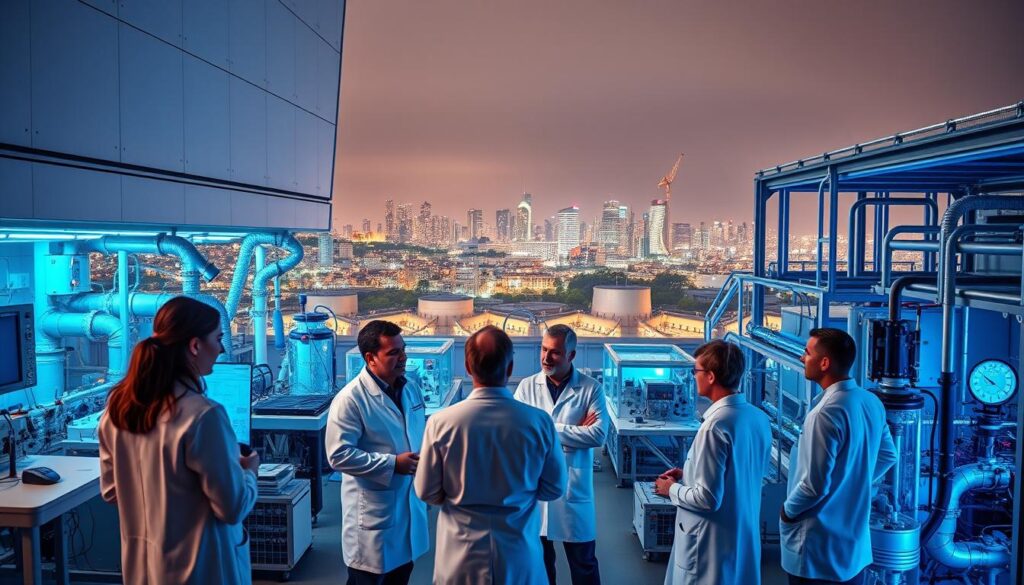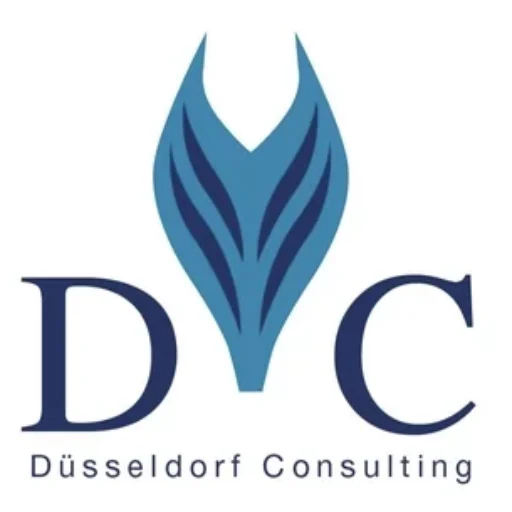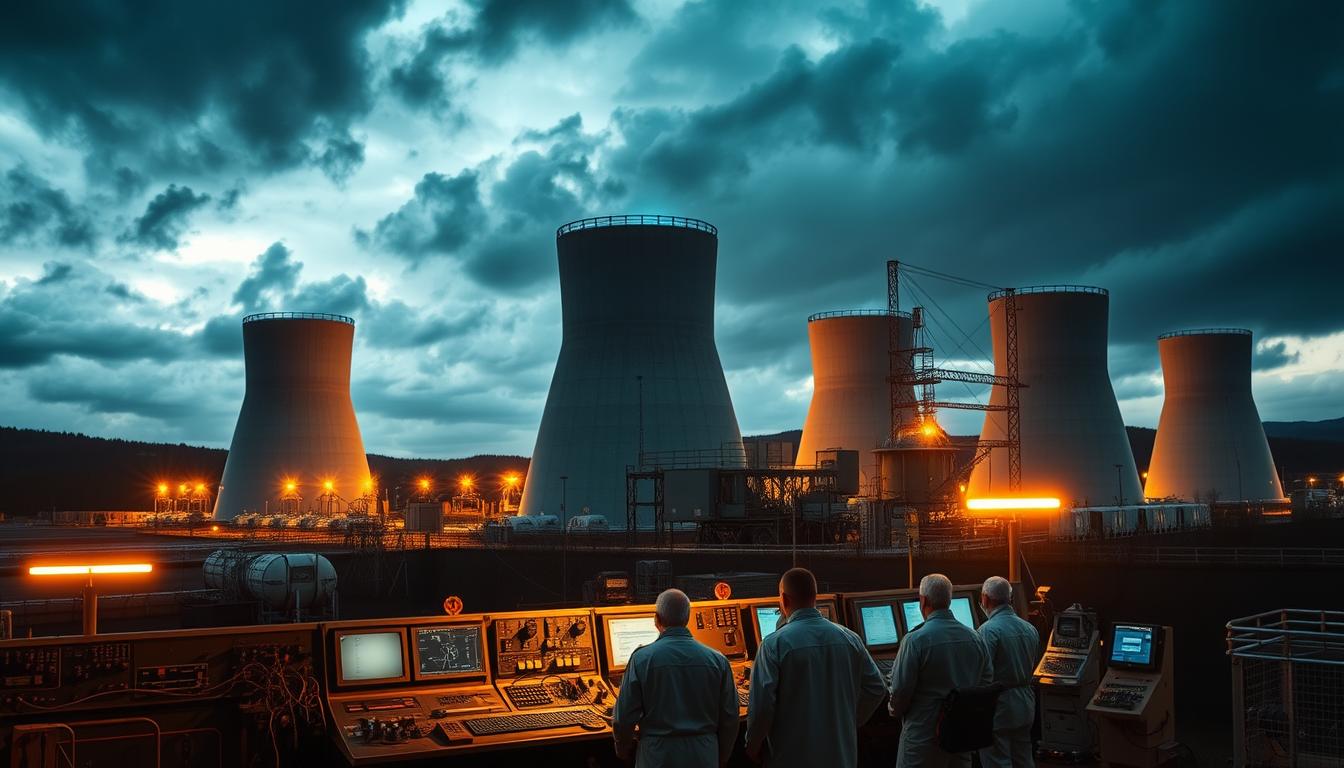Nuclear fusion, the process that powers the sun, is a promising source of clean energy. Germany is at the forefront of fusion research, contributing significantly to the development of this technology.
With a rich history in scientific innovation, Germany’s efforts in nuclear fusion are part of a broader international collaboration. The country’s research institutions are working together to harness the potential of fusion power.
The future of energy production is being shaped by current research, with Thermonuclear Fusion Research Consortia playing a crucial role. Germany’s involvement in these consortia underscores its commitment to clean energy.
Key Takeaways
- Germany is a leading player in nuclear fusion research.
- The country’s efforts are part of an international collaboration.
- Fusion power has the potential to be a significant source of clean energy.
- Research institutions in Germany are at the forefront of fusion technology.
- Germany’s involvement in thermonuclear fusion research consortia is crucial for the development of fusion power.
Overview of Thermonuclear Fusion
Germany is at the forefront of thermonuclear fusion research, a field that could provide limitless clean energy. Thermonuclear fusion, the process that powers the sun, involves combining atomic nuclei to form a heavier nucleus, releasing vast amounts of energy.
Definition and Importance of Fusion Energy
Fusion energy is produced by fusing atomic nuclei together, a process that releases a significant amount of energy. This energy source is considered clean and sustainable because it does not produce greenhouse gases or long-lived radioactive waste. The importance of fusion energy lies in its potential to provide a nearly limitless supply of energy, making it an attractive alternative to fossil fuels and traditional nuclear fission.
The process of fusion is the same as that which powers the sun and other stars. By harnessing this process, Germany aims to create a new, sustainable energy source that can help mitigate climate change and ensure energy security.
Key Differences Between Fusion and Fission
While both fusion and fission are nuclear processes used to generate energy, they have distinct differences. Nuclear fission involves splitting a heavy atomic nucleus into two or more smaller nuclei, along with the release of energy. In contrast, nuclear fusion involves combining two or more light nuclei to form a single, heavier nucleus, also releasing energy.
The key differences between fusion and fission include:
- Fusion releases more energy per reaction than fission.
- Fusion produces less radioactive waste compared to fission.
- The fuel used in fusion (usually isotopes of hydrogen) is more abundant than the fuel used in fission (usually uranium or plutonium).
- Fusion reactions are inherently safer because they require precise conditions to maintain, and if these conditions are not met, the reaction stops.
These differences highlight why fusion is considered a more promising and cleaner source of energy compared to fission.
Historical Context of Fusion Research in Germany
The journey of fusion research in Germany began in the 1950s, marking the start of a long-term commitment to this innovative energy source. Germany’s involvement in nuclear fusion research has been significant, with various milestones achieved over the decades.
Milestones in German Fusion Development
Germany’s fusion research program has seen several key developments. Some of the notable milestones include:
- The establishment of the Max Planck Institute for Plasma Physics in the 1960s, which has been a cornerstone of German fusion research.
- The development of advanced plasma confinement techniques, such as the stellarator and tokamak configurations.
- Participation in international collaborations, including the ITER project, which has been instrumental in advancing fusion technology.
As noted by a prominent researcher, “Germany’s commitment to fusion research has been unwavering, with significant investments in both human capital and infrastructure.”
“The future of fusion energy is bright, and Germany is poised to play a leading role in its development.”
| Year | Milestone | Description |
|---|---|---|
| 1950s | Initiation of Fusion Research | Germany begins its journey in nuclear fusion research. |
| 1960s | Establishment of MPI for Plasma Physics | A key institution for fusion research is founded. |
| 2000s | Participation in ITER | Germany joins the international ITER project. |
Influence of Global Fusion Initiatives
Germany’s fusion research has been significantly influenced by global initiatives. The country’s participation in the ITER project is a prime example, demonstrating its commitment to international collaboration in the pursuit of fusion energy. For more information on Germany’s involvement in nuclear fusion research, visit this page.
The influence of global initiatives can be seen in the advancements made in fusion technology, with Germany contributing to and benefiting from international collaborations. As stated in a recent report, “Global cooperation has been crucial in overcoming the technical challenges associated with fusion research.”
Major Thermonuclear Fusion Research Organizations
Several leading research organizations in Germany are driving the country’s thermonuclear fusion research forward. These institutions are pivotal in advancing the understanding and technology required for fusion energy.
Max Planck Institute for Plasma Physics
The Max Planck Institute for Plasma Physics (IPP) is a cornerstone of Germany’s fusion research efforts. It is renowned for its work on the stellarator and tokamak devices, which are crucial for achieving controlled nuclear fusion. The IPP collaborates closely with international partners, particularly on the Wendelstein 7-X (W7-X) stellarator, a significant experiment in the pursuit of fusion energy.
Forschungszentrum Jülich
Forschungszentrum Jülich (FZJ) is another key player in Germany’s fusion research landscape. It is involved in various aspects of fusion technology, including materials research and the development of components for future fusion power plants. FZJ’s contributions to the ITER project and its participation in the European fusion research program underscore its commitment to advancing fusion energy.
Helmholtz Zentrum Dresden-Rossendorf
The Helmholtz Zentrum Dresden-Rossendorf (HZDR) contributes significantly to the field through its research on plasma physics and the development of novel diagnostic techniques for fusion experiments. Its work complements the efforts of other institutions, pushing the boundaries of what is possible in fusion research.
The collaboration among these institutions, along with their international partners, is a testament to Germany’s comprehensive approach to developing fusion energy. The synergy between the Max Planck Institute for Plasma Physics, Forschungszentrum Jülich, and Helmholtz Zentrum Dresden-Rossendorf exemplifies the country’s commitment to overcoming the challenges associated with thermonuclear fusion.
| Institution | Key Contributions | Notable Projects |
|---|---|---|
| Max Planck Institute for Plasma Physics | Stellarator and tokamak research | Wendelstein 7-X (W7-X) stellarator |
| Forschungszentrum Jülich | Materials research and component development | ITER project |
| Helmholtz Zentrum Dresden-Rossendorf | Plasma physics and diagnostic techniques | Novel diagnostic techniques for fusion experiments |
The table above highlights the key contributions and notable projects of the major thermonuclear fusion research organizations in Germany. It is evident that these institutions are at the forefront of fusion research, driving innovation and collaboration.
The Role of ITER in German Research
As a key participant in the ITER project, Germany is contributing substantially to the global fusion research community. The ITER project is an international collaboration aimed at demonstrating the feasibility of fusion power, and Germany’s involvement is crucial to its success.
Germany’s Contributions to ITER
Germany is actively contributing to the development of key components and technologies for the ITER tokamak. The country’s research institutions, including the Max Planck Institute for Plasma Physics and Forschungszentrum Jülich, are playing a vital role in designing and manufacturing critical ITER components.
These contributions not only enhance the ITER project’s chances of success but also provide German researchers with valuable experience and expertise in fusion technology. By participating in ITER, Germany is strengthening its position as a leader in fusion research.
Expected Outcomes for the German Research Community
The involvement in ITER is expected to yield significant benefits for the German research community. By collaborating on ITER, German researchers will gain access to cutting-edge technology and international expertise, fostering innovation and advancing the country’s fusion research program.
The expected outcomes include advancements in plasma physics, materials science, and engineering, all of which are crucial for the development of commercial fusion power plants. Furthermore, Germany’s participation in ITER will facilitate the training of the next generation of fusion researchers and engineers, ensuring the country’s continued leadership in this field.
Advanced Technologies in Fusion Research
Germany’s thermonuclear fusion research is at the forefront, driven by advancements in plasma physics and magnetic confinement. The development of these advanced technologies is crucial for achieving controlled nuclear fusion.
Plasma Physics and Its Challenges
Plasma physics is a fundamental aspect of fusion research, involving the study of ionized gases at extremely high temperatures. One of the significant challenges is maintaining the stability of the plasma, which is essential for sustaining the fusion reaction.
The Max Planck Institute for Plasma Physics is a leading research center in this area, focusing on understanding plasma behavior and developing techniques to confine and stabilize plasma.
Innovations in Magnetic Confinement
Magnetic confinement is a technique used to contain the hot plasma, necessary for achieving fusion. Innovations in this area include the development of advanced magnetic confinement devices, such as stellarators and tokamaks.
Key advancements in magnetic confinement include:
- Improved superconducting materials for stronger magnetic fields
- Enhanced computational models for simulating plasma behavior
- Innovative designs for stellarator and tokamak devices
The Forschungszentrum Jülich is actively involved in these developments, contributing to the global effort in fusion research.
A comparative analysis of different magnetic confinement techniques is crucial for identifying the most promising approaches. The table below summarizes some key aspects:
| Technique | Advantages | Challenges |
|---|---|---|
| Tokamak | Well-established concept, high plasma confinement | Complex engineering, risk of plasma disruptions |
| Stellarator | Potential for steady-state operation, reduced risk of disruptions | Complex coil designs, high construction costs |
The development of these advanced technologies is pivotal for the success of nuclear fusion projects in Germany. By pushing the boundaries of plasma physics and magnetic confinement, German research institutions are making significant contributions to the global fusion research community.
Collaborative Efforts in Fusion Research
The pursuit of fusion energy in Germany is characterized by robust collaborations among research institutions and international partners. This collaborative environment fosters innovation, accelerates the development of fusion technology, and addresses the complex challenges associated with achieving controlled nuclear fusion.
National Collaborations Among Research Institutions
Nationally, German research institutions collaborate closely to advance fusion research. The Max Planck Institute for Plasma Physics (IPP), Forschungszentrum Jülich, and Helmholtz Zentrum Dresden-Rossendorf are key players in this collaborative effort. They share resources, expertise, and knowledge to drive progress in plasma physics, materials science, and fusion reactor design.
For instance, the IPP and Forschungszentrum Jülich work together on the development of advanced plasma confinement techniques, a crucial aspect of fusion research. Such collaborations not only enhance the technical capabilities of individual institutions but also contribute to a more cohesive national strategy for fusion energy development.
- Joint research projects on plasma confinement and materials science.
- Shared use of experimental facilities, such as the Wendelstein 7-X stellarator.
- Collaborative training programs for young researchers.
International Partnerships and Projects
Germany is also an active participant in international fusion research initiatives. The country’s involvement in the ITER (International Thermonuclear Experimental Reactor) project is a prime example of its commitment to global collaboration in fusion energy. ITER, currently under construction in France, aims to demonstrate the feasibility of fusion power by achieving a sustained plasma state.
“The ITER project represents a significant step towards the realization of fusion energy, bringing together researchers and engineers from around the world to tackle one of the most complex energy challenges.” – Dr. Bernard Bigot, ITER Director-General.
Germany’s contributions to ITER include the development and supply of critical components, such as the pre-compression rings and the magnet systems. This participation not only advances the ITER project but also enhances Germany’s own fusion research capabilities through the transfer of knowledge and technology.
| Institution | Role in ITER | Contribution |
|---|---|---|
| Max Planck Institute for Plasma Physics | Plasma Confinement Expertise | Development of advanced plasma confinement techniques. |
| Forschungszentrum Jülich | Materials Research | Research on plasma-facing materials and components. |
| Helmholtz Zentrum Dresden-Rossendorf | Plasma-Wall Interaction | Studies on plasma-wall interactions and material behavior. |

The collaborative efforts in fusion research, both at the national and international levels, underscore Germany’s commitment to developing a sustainable and clean energy source. Through these partnerships, Germany is poised to play a significant role in the global pursuit of fusion energy.
Government Funding and Policy Support
Government funding and policy initiatives play a crucial role in advancing thermonuclear fusion research in Germany. The country’s commitment to becoming a leader in fusion technology is backed by substantial financial investments and strategic policy frameworks.
Overview of German Government Initiatives
The German government has launched several initiatives aimed at supporting thermonuclear fusion research. These initiatives are designed to foster collaboration among research institutions, industry partners, and international organizations. The government recognizes the potential of fusion energy to contribute significantly to Germany’s energy transition (Energiewende) goals.
Key government initiatives include the establishment of research consortia that bring together leading scientists and engineers from various disciplines. These consortia are tasked with addressing the complex challenges associated with achieving controlled thermonuclear fusion. By pooling resources and expertise, the consortia are better equipped to tackle the technical barriers to fusion energy.
Funding Programs Supporting Fusion Research
Germany has implemented various funding programs to support fusion research, providing financial resources to research institutions and projects. The Helmholtz Association, a prominent research organization in Germany, plays a significant role in coordinating fusion research efforts. Through its research programs, the Helmholtz Association supports innovative projects and collaborations that advance fusion technology.
Additionally, the German government has allocated funds for international collaborations, such as the ITER project. Germany’s participation in ITER not only contributes to the global fusion research effort but also provides opportunities for German researchers to engage in cutting-edge fusion experiments and technology development.
By maintaining a strong commitment to funding and policy support, Germany is positioning itself at the forefront of thermonuclear fusion research. The government’s proactive approach is crucial for overcoming the technical and scientific challenges that must be addressed to make fusion energy a reality.
Challenges Facing Thermonuclear Fusion in Germany
Germany’s thermonuclear fusion research faces multiple hurdles, from technical barriers to societal concerns. Achieving controlled nuclear fusion, a crucial step towards harnessing fusion energy, remains one of the significant technical challenges.
Technical Barriers and Research Difficulties
The technical barriers in thermonuclear fusion research are multifaceted. Achieving and sustaining the high temperatures and pressures needed for fusion is a complex task. Researchers are working on improving magnetic confinement techniques and developing materials that can withstand the extreme conditions inside a fusion reactor.
Moreover, the development of advanced plasma physics models and simulations is crucial for understanding and predicting plasma behavior. These models help in optimizing the design and operation of fusion devices.
Public Perception and Acceptance Issues
Public perception and acceptance are vital for the success of thermonuclear fusion research in Germany. Educating the public about the benefits and safety of fusion energy is essential. Unlike nuclear fission, fusion offers a cleaner and safer form of energy production, with less radioactive waste.
To address public concerns, research institutions and policymakers are engaging in awareness campaigns and educational programs. These initiatives aim to inform the public about the potential of fusion energy to contribute to Germany’s energy transition (Energiewende) and reduce carbon emissions.
Future Prospects of Fusion Energy in Germany
As Germany continues its journey towards a sustainable energy future, fusion energy stands out as a promising solution. The country’s commitment to reducing carbon emissions and transitioning to a cleaner energy mix is well-aligned with the potential benefits of fusion energy.

Potential Contributions to Energy Transition
Fusion energy has the potential to contribute significantly to Germany’s energy transition (Energiewende) by providing a nearly limitless, carbon-free source of electricity. According to experts, fusion could play a crucial role in stabilizing the grid and ensuring a reliable energy supply as the country increases its reliance on intermittent renewable sources.
A report by a leading energy research institution noted, “Fusion power plants could become a cornerstone of Germany’s energy landscape, offering a clean and constant source of energy that complements the existing renewable energy infrastructure.”
“The successful development of fusion energy would be a game-changer for Germany’s energy security and climate goals.”
Strategic Goals of German Fusion Research
The strategic goals of German fusion research are centered around achieving commercially viable fusion power plants. This involves advancing the scientific understanding of plasma physics, developing innovative materials and technologies, and collaborating with international partners on large-scale projects like ITER.
| Research Area | Objective | Status |
|---|---|---|
| Plasma Physics | Understand and control plasma behavior | Ongoing research |
| Materials Science | Develop materials that can withstand fusion conditions | Advanced development |
| ITER Collaboration | Contribute to the development of a global fusion prototype | Active participation |
By focusing on these strategic goals, Germany’s fusion research community is poised to make significant contributions to the global effort to harness fusion energy, ultimately enhancing the country’s energy security and supporting its climate objectives.
Conclusion and Next Steps
Thermonuclear fusion research in Germany is a vibrant field, driven by collaborations among top research institutions, including the Max Planck Institute for Plasma Physics and Forschungszentrum Jülich. These Germany fusion research institutions are pivotal in advancing fusion technology.
The progress made in fusion energy collaborations Germany is significant, with the country playing a crucial role in the international ITER project. Continued support and collaboration are essential for overcoming the technical and societal challenges associated with fusion energy.
Key Takeaways and Future Directions
The key to achieving commercially viable fusion power lies in sustained investment in research and development. Germany’s strategic goals for fusion research are aligned with its energy transition objectives, emphasizing the need for clean and sustainable energy sources.
Advancing Fusion Research
To move forward, it is crucial to maintain momentum in fusion research. This involves not only advancing the technical aspects but also fostering public understanding and acceptance of fusion energy. By doing so, Germany can continue to be at the forefront of fusion research, contributing to a sustainable energy future.
FAQ
What is thermonuclear fusion?
Thermonuclear fusion is the process by which atomic nuclei combine to form a heavier nucleus, releasing energy in the process. This is the same process that powers the sun.
Why is fusion energy important?
Fusion energy has the potential to provide a nearly limitless supply of clean energy, making it an attractive alternative to fossil fuels and traditional nuclear fission.
What is Germany’s role in fusion research?
Germany is actively involved in fusion research, with a focus on developing the necessary technologies and expertise to harness this energy source. The country is home to several leading research institutions, including the Max Planck Institute for Plasma Physics, Forschungszentrum Jülich, and Helmholtz Zentrum Dresden-Rossendorf.
What is the ITER project?
The ITER (International Thermonuclear Experimental Reactor) project is a global collaboration aimed at demonstrating the feasibility of fusion power. Germany is an active participant in ITER, contributing to the development of key components and technologies.
What are the challenges facing fusion research in Germany?
Technical barriers, such as achieving controlled nuclear fusion, remain a significant hurdle. Additionally, public perception and acceptance issues need to be addressed through education and awareness campaigns.
How is the German government supporting fusion research?
The German government plays a crucial role in supporting fusion research through funding and policy initiatives. Various programs have been established to support the development of fusion technologies, providing financial resources and strategic guidance to research institutions.
What is the potential impact of fusion energy on Germany’s energy transition?
Fusion energy is expected to play a crucial role in Germany’s energy transition, providing a clean and sustainable source of energy. The country’s fusion research community is working towards achieving strategic goals, including the development of commercially viable fusion power plants.
What are the key technologies being developed in fusion research?
Fusion research relies on the development of advanced technologies, including plasma physics and magnetic confinement. German research institutions are at the forefront of these developments, working on innovative solutions to the challenges associated with achieving controlled nuclear fusion.
How do German research institutions collaborate on fusion research?
National collaborations among research institutions facilitate the sharing of expertise and resources, while international partnerships enable the pooling of knowledge and experience on a global scale.
What is the significance of Germany’s participation in the ITER project?
Germany’s participation in ITER is expected to benefit the country’s research community, providing valuable experience and expertise in fusion research. The ITER project is a crucial step towards demonstrating the feasibility of fusion power.




